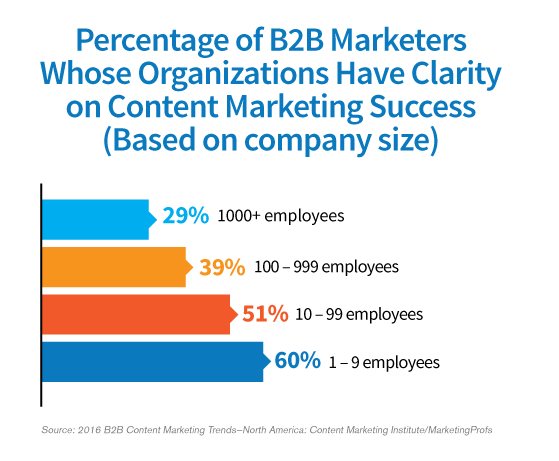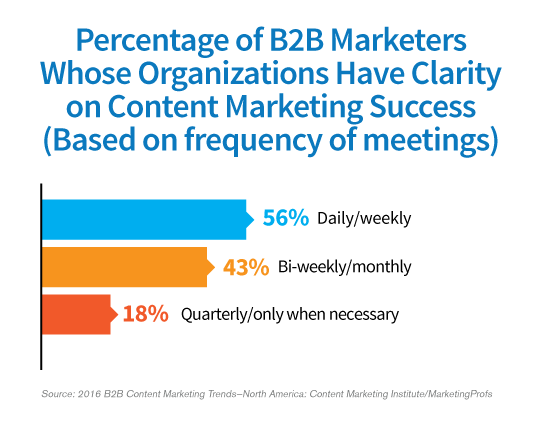
One stat from this year’s B2B content marketing research surprised me:
Only 44% of B2B marketers are clear on what content marketing success looks like.
To me, this is incredible, especially as it plays into another finding – only 30% of marketers consider themselves to be effective.
Why are you even using content marketing if you don’t know what success is – and how it will help your business move forward?
Why is this number so low, and, more importantly, what can marketers do about this? CMI shared the survey results around success and asked our B2B research roundtable to tackle the issue (video below).
A big thanks to the participants: Ardath Albee, B2B marketing strategist with Marketing Interactions and author of Digital Relevance; Vishal Khanna, director of digital marketing for Wake Forest Innovations; Carla Johnson, president of Type A Communications and co-author of Experiences, the 7th Era of Marketing; Jeannine Rossignol, vice president of marketing for Xerox Consulting and Analytics Services; and Linda Crowe, vice president, digital marketing solutions of Brightcove.
What success looks like in organizations today
The survey asked an optional, open-ended question: What does an effective or successful content marketing program look like in your organization? The answers generally fell into these categories:
- Building an audience
- Generating leads
- Helping with sales
- Publishing content consistently
- Elevating the perception of the brand
One of the trends I saw in the survey results, though, was that many of the success metrics were “fuzzy,” such as this one:
“BETTER traffic, leads and sales.”
While content marketing can indeed help you get better traffic leads and sales (in short, help you build a better customer), you need to be able to trace success to something that is quantifiable. The above quote is just one example where I found myself wondering, “How would you measure this? How do you define better? And does better mean the same thing across this organization?”
An under-appreciated success metric
While there is no one right metric to track, many organizations would benefit from focusing on subscribers, which Joe Pulizzi recently discussed in his post No Subscription Goal for Your Content Marketing? Prepare to Be Ignored.
Not all subscribers are created equal, either. In the subscription hierarchy below, you can see that email subscribers offer the most benefit because you own the data associated with your subscribers – even though subscribers can always decide if they want to hear from you. This is unlike platforms like Facebook, Twitter, and LinkedIn where your subscribers are tied to that platform.
The Subscription Hierarchy
Michael Brenner’s comment on Joe’s post speaks to the value of subscribers to a B2B brand:
This also completely confirms what we found when I was running content marketing at SAP. We spent a YEAR trying to convert visitors to the site to something the business could value. We tested dozens of approaches. None of them worked. What we finally found was that when we focused on building subscribers, and then followed up with the subscribers with hard offers like event invitations, e-books, other pieces of thought leadership, and even “click to speak to a sales rep,” the subscribers were 10X more likely to convert to a lead.
Why clarity of success may not be so easy
I dug into the report to see if certain groups have a clearer vision of success than others to see if there is any prescriptive advice to offer, and here is what I found.
Marketers at small companies have more clarity than those who work for large companies.
Marketers who meet with their teams more frequently are more likely to know what success looks like.
Marketers with a documented content marketing strategy and editorial mission are much more likely to know what success looks like. (For the 32% of respondents who say they have a documented strategy, I wonder how sound a strategy they have if they don’t know what success looks like.)
What is the link between all of these? Communication. So while you need to figure out what success is and how to track it, you also need to communicate it.
How to better communicate success
If you are a marketing leader who is setting the strategy for your content marketing program, you must:
- Get buy-in from management on what they need to see to quantify your content marketing program as a success.
- Understand what metrics support success as viewed by management. Here is a list of some common goals and metrics.
Click to enlarge
- Make it abundantly clear to anyone who is involved in content marketing what success looks like. This includes documenting this criteria – and communicating it on a regular basis. Not only does this keep everyone on the same page, but it also helps people stay on track when roles invariably change.
A simple suggestion is to track the metrics in a Google Doc or Excel spreadsheet like this:
Click to enlarge
Keep in mind that there are various metrics you may want to track. Jeannine presented me with an “aha” moment when she explained the two types of metrics:
- Useful metrics are used by marketing to know if programs are on track. Examples include open rates and click-through rates.
- Meaningful metrics are those that are reported to the business. Examples include leads in the pipeline, qualified leads, or whatever is important to the business leaders.
In short, not only do you need to define or understand what success looks like for management, but you also need to figure out how you are going to track individual pieces of content.
Of course, you will also want to continually meet with your team as well – with the specific focus on how you will all prioritize and create programs that support what success looks like to your organization. (Want a handy meeting agenda to get started? Check out the sample at the end of Andy Crestodina’s post.)
If you are a marketing practitioner, demand to know what success looks like for your organization – and your efforts.
Once you know where all of your efforts should be pointed, you can then start to get super-focused. This idea from Vishal during the roundtable is spot on:
I started doing this one simple thing where I’d go into work every morning and I’d say, “How am I going to drive revenue today?” It was a real simple statement, but that ended up driving my choice of those 85 hats to wear within the next four hours of that morning. It was extremely helpful. We’re a small group as well, so thinking that way helps use that limited amount of time and resources.
I’d love to hear from you: What does content marketing success look like for you? Or what tips do you have for those who need to identify this?
View the other B2C and B2B research videos in these roundtable discussions:
- A 4-Step Approach to Create Content that Hits the Mark
- How to Make Marketing Meetings More Productive and Less Soul-Sucking
- Why Strong Writing Is a Skill to Prioritize in 2016 (And How to Hire Great Writers)
- The One Brief Statement That Will Refine Your Content Marketing
- 3 (Easy) Ways to Truly Surprise Your Audience
Want to learn more about how to measure success? Read the insight, tips, and more in CMI’s measuring success content hub.
Cover image by Mconnors via MorgueFile






